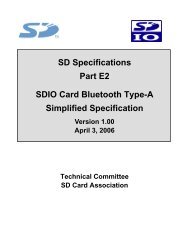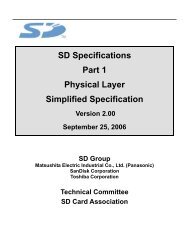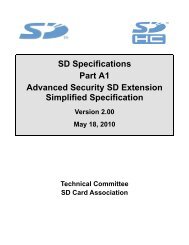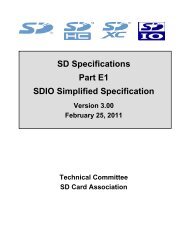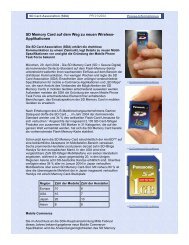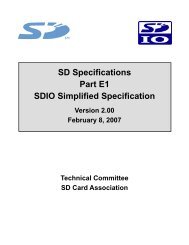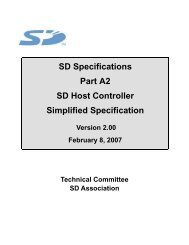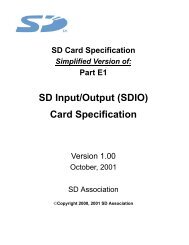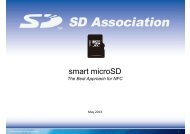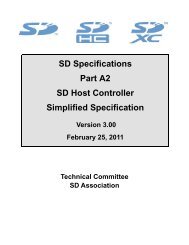SD Specifications Part 1 UHS-II Simplified Addendum - SD Association
SD Specifications Part 1 UHS-II Simplified Addendum - SD Association
SD Specifications Part 1 UHS-II Simplified Addendum - SD Association
You also want an ePaper? Increase the reach of your titles
YUMPU automatically turns print PDFs into web optimized ePapers that Google loves.
<strong>UHS</strong>-<strong>II</strong> <strong>Simplified</strong> <strong>Addendum</strong> Version 1.01©Copyright 2010-2013 <strong>SD</strong> Card <strong>Association</strong>1. GeneralThis Simpliied <strong>Addendum</strong> defines an additional category to the <strong>Part</strong> 1 Physical Layer <strong>Simplified</strong>Specification Version 4.10. The following sections describe additional and modified parts of the basespecification for this new category.Key background factors behind Ultra High Speed Type <strong>II</strong> (<strong>UHS</strong>-<strong>II</strong>) Specification are shown below:• High speed interface is required to handle large volumes of HD (High Definition) contentsIn recent years, the number of <strong>SD</strong>-applications which handle large amount of data is increasingsteadily with an increase in HD (High Definition) contents (HD, Super-HD, 3D-TV, etc.). At thesame time, the data size of HD contents is also increasing year by year.<strong>UHS</strong>-<strong>II</strong> is necessary to meet the ultrahigh-speed requirement to handle HD contents and fartherlarge-capacity contents in the future.• Interface should be widely available for many kinds of hostsIt is difficult to keep signal integrity at high-speed data transfer especially for mobile devices.Generally, board design of hosts becomes more difficult with high speed interface. <strong>UHS</strong>-<strong>II</strong> shouldbe considered both high-speed and availability for many kinds of hosts.• Reusability of legacy resource (IPs, software, etc.) is important for host developmentHosts require the compatibility with legacy protocol for their efficient development.For example, in <strong>SD</strong> protocol, preserving the <strong>SD</strong> legacy infrastructures (CMD, RES, States, Status,Errors, etc.) provides efficient development with <strong>SD</strong> hosts, and this leads to a speedy expansion of<strong>UHS</strong>-<strong>II</strong> applications.• Interoperability and compatibility to Legacy <strong>SD</strong> I/F is important to avoid market confusionHosts and Devices require also the interoperability and compatibility with Legacy <strong>SD</strong> cardsinstalled based to enable <strong>UHS</strong>-<strong>II</strong> specifications to be smoothly adopted by the market.• Low voltage, low power consumption and low EMI are needed for mobile devicesTo apply new high-speed interface to many kinds of mobile devices, it is important to realize lowpower consumption and low EMI.Some low power and low EMI techniques need to be considered for <strong>UHS</strong>-<strong>II</strong>.• Multiple device connectivity for minimizing the number of ports and circuit size is requiredMulti device connectivity is required to reduce the number of ports and circuit size for lowerdeveloping cost.System features of <strong>UHS</strong>-<strong>II</strong> Specification based on the background are described in the next chapter.1



